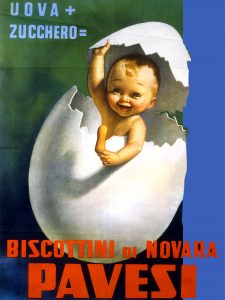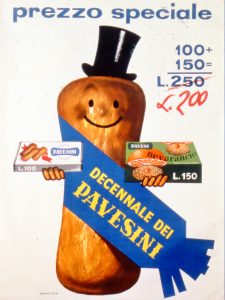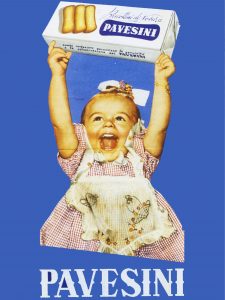The Pavesini Clock

by Emmanuel Grossi
Pavesini were created in 1948 under the original denomination of “Pavesi Little Biscuits of Novara”. However, it was only in 1958, ten years later, thanks to an advertising poster by the famous designer Armando Testa, that they started to express their true potential. Their target audience expanded to consumers of all ages and they took on the connotation of light snacks to eat on a break during the day (even though they were still presented as baby products by the motherly figure of Elda Lanza on Carosello).
The image created in 1960 by Erberto Carboni (formerly the creator of the successful graphic images for Barilla and many other companies, including RAI) was of crucial importance: a clock on whose dial every hour is marked by a biscuit, to reaffirm the concept that: “It is always time for Pavesini”.
The idea was immediately turned into a film concept, by engaging the best cartoonists of the time, brothers Nino and Toni Pagot, who shot a two-minute movie divided into four sections: in the family, at school, on the train, and at the stadium. The thread that tied these all together was a talking clock, that in some way became the narrator of the commercial. This created a series of problems for the young musician who was approaching the world of advertising (and who later became a great protagonist of it): Ario Albertarelli.
It is he himself to tell us about his misadventures:
“It was a rather contorted job. First misunderstanding: the talking clock. I did not have precise indications and I thought it should speak by marking the time. Then I auditioned various actors, even Alighiero Noschese… And instead they chose one who said ‘It’s always time for Pavesini’ all in one breath. They wanted a clock that spoke like a human, not “like a clock” …
Then there was the problem of music: they made me rewrite it four times! Originally it was beautiful, but wit all of the successive interventions it came out fake sounding, and it was not flowing at all. I had composed a theme that varied in arrangement and tonality for each of the four episodes. This was very suitable for biscuits, with the saxophone giving the idea of the train, and featuring an excellent percussionist, the son of the orchestra conductor Enzo Ceragioli …
But I had to write it anew, because Eng. Mario Troso, Director of the Pavesi Advertising Office, insisted that he wanted the sound of a pendulum clock in the background. In those days, those types of crazy things happened! Both he and the Pagot brothers started from the assumption that in Milan anything could be found easily. Troso made me go to his office with a recorder weighing seven kilos and forty different clock sounds, both atomic and real … and he didn’t like even one of them! So I searched in music records: even those weren’t good for him. Recording a pendulum clock is not easy! To begin with: who will lend you a valuable pendulum clock? And one is not enough! Fortunately, in TTC there was an assistant editor, Alberto Moro, who had been collecting film clips, period music … up to creating a large film library with all kinds of repertoire material. And I solved the problem that way.”
But this was just the debut of Albertarelli with Pavesi. Indeed soon a long lasting collaboration with Marco Biassoni would begin, leading to the success of the famous carousels of the Knights of the Round Table…









